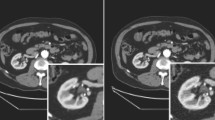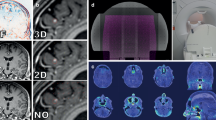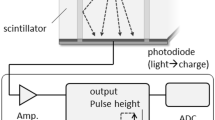Abstract
Objectives
To evaluate the image quality of deep learning–based reconstruction (DLR), model-based (MBIR), and hybrid iterative reconstruction (HIR) algorithms for lower-dose (LD) unenhanced head CT and compare it with those of standard-dose (STD) HIR images.
Methods
This retrospective study included 114 patients who underwent unenhanced head CT using the STD (n = 57) or LD (n = 57) protocol on a 320-row CT. STD images were reconstructed with HIR; LD images were reconstructed with HIR (LD-HIR), MBIR (LD-MBIR), and DLR (LD-DLR). The image noise, gray and white matter (GM-WM) contrast, and contrast-to-noise ratio (CNR) at the basal ganglia and posterior fossa levels were quantified. The noise magnitude, noise texture, GM-WM contrast, image sharpness, streak artifact, and subjective acceptability were independently scored by three radiologists (1 = worst, 5 = best). The lesion conspicuity of LD-HIR, LD-MBIR, and LD-DLR was ranked through side-by-side assessments (1 = worst, 3 = best). Reconstruction times of three algorithms were measured.
Results
The effective dose of LD was 25% lower than that of STD. Lower image noise, higher GM-WM contrast, and higher CNR were observed in LD-DLR and LD-MBIR than those in STD (all, p ≤ 0.035). Compared with STD, the noise texture, image sharpness, and subjective acceptability were inferior for LD-MBIR and superior for LD-DLR (all, p < 0.001). The lesion conspicuity of LD-DLR (2.9 ± 0.2) was higher than that of HIR (1.2 ± 0.3) and MBIR (1.8 ± 0.4) (all, p < 0.001). Reconstruction times of HIR, MBIR, and DLR were 11 ± 1, 319 ± 17, and 24 ± 1 s, respectively.
Conclusion
DLR can enhance the image quality of head CT while preserving low radiation dose level and short reconstruction time.
Key Points
• For unenhanced head CT, DLR reduced the image noise and improved the GM-WM contrast and lesion delineation without sacrificing the natural noise texture and image sharpness relative to HIR.
• The subjective and objective image quality of DLR was better than that of HIR even at 25% reduced dose without considerably increasing the image reconstruction times (24 s vs. 11 s).
• Despite the strong noise reduction and improved GM-WM contrast performance, MBIR degraded the noise texture, sharpness, and subjective acceptance with prolonged reconstruction times relative to HIR, potentially hampering its feasibility.






Similar content being viewed by others

Abbreviations
- AiCE:
-
Advanced Intelligent Clear-IQ Engine
- CNR:
-
Contrast-to-noise ratio
- DLR:
-
Deep learning–based reconstruction
- GM:
-
Gray matter
- HIR:
-
Hybrid iterative reconstruction
- HU:
-
Hounsfield unit
- MBIR:
-
Model-based iterative reconstruction
- NPS:
-
Noise power spectrum
- WM:
-
White matter
References
Powers WJ, Rabinstein AA, Ackerson T et al (2019) Guidelines for the early management of patients with acute ischemic stroke: 2019 update to the 2018 guidelines for the early management of acute ischemic stroke: a guideline for healthcare professionals from the American Heart Association/American Stroke Association. Stroke 50:e344–e418
Kleindorfer DO, Towfighi A, Chaturvedi S et al (2021) 2021 guideline for the prevention of stroke in patients with stroke and transient ischemic attack: a guideline from the American Heart Association/American Stroke Association. Stroke 52:e364–e467
Schweitzer AD, Niogi SN, Whitlow CT, Tsiouris AJ (2019) Traumatic brain injury: imaging patterns and complications. Radiographics 39:1571–1595
Sprawls P (1992) AAPM tutorial. CT image detail and noise. Radiographics 12:1041–1046
Weinstein MA, Duchesneau PM, MacIntyre WJ (1977) White and gray matter of the brain differentiated by computed tomography. Radiology 122:699–702
Yuan MK, Tsai DC, Chang SC et al (2013) The risk of cataract associated with repeated head and neck CT studies: a nationwide population-based study. AJR Am J Roentgenol 201:626–630
Gelfand AA, Josephson SA (2011) Substantial radiation exposure for patients with subarachnoid hemorrhage. J Stroke Cerebrovasc Dis 20:131–133
Geyer LL, Schoepf UJ, Meinel FG et al (2015) State of the art: iterative CT reconstruction techniques. Radiology 276:339–357
Stiller W (2018) Basics of iterative reconstruction methods in computed tomography: a vendor-independent overview. Eur J Radiol 109:147–154
Willemink MJ, Noël PB (2019) The evolution of image reconstruction for CT-from filtered back projection to artificial intelligence. Eur Radiol 29:2185–2195
Nagayama Y, Nakaura T, Tsuji A et al (2017) Radiation dose reduction using 100-kVp and a sinogram-affirmed iterative reconstruction algorithm in adolescent head CT: impact on grey-white matter contrast and image noise. Eur Radiol 27:2717–2725
Mirro AE, Brady SL, Kaufman RA (2016) Full dose-reduction potential of statistical iterative reconstruction for head CT protocols in a predominantly pediatric population. AJNR Am J Neuroradiol 37:1199–1205
Southard RN, Bardo DME, Temkit MH, Thorkelson MA, Augustyn RA, Martinot CA (2019) Comparison of iterative model reconstruction versus filtered back-projection in pediatric emergency head CT: dose, image quality, and image-reconstruction times. AJNR Am J Neuroradiol 40:866–871
Kim HG, Lee HJ, Lee SK, Kim HJ, Kim MJ (2017) Head CT: image quality improvement with ASIR-V using a reduced radiation dose protocol for children. Eur Radiol 27:3609–3617
Mileto A, Guimaraes LS, McCollough CH, Fletcher JG, Yu L (2019) State of the art in abdominal CT: the limits of iterative reconstruction algorithms. Radiology 293:491–503
Nakamura Y, Higaki T, Tatsugami F et al (2020) Possibility of deep learning in medical imaging focusing improvement of computed tomography image quality. J Comput Assist Tomogr 44:161–167
Nagayama Y, Sakabe D, Goto M et al (2021) Deep learning–based reconstruction for lower-dose pediatric CT: technical principles, image characteristics, and clinical implementations. Radiographics 41:1936–1953
Nakamura Y, Higaki T, Tatsugami F et al (2019) Deep learning–based CT image reconstruction: initial evaluation targeting hypovascular hepatic metastases. Radiol Artif Intel 1:e180011
Akagi M, Nakamura Y, Higaki T et al (2019) Deep learning reconstruction improves image quality of abdominal ultra-high-resolution CT. Eur Radiol 29:6163–6171
Tatsugami F, Higaki T, Nakamura Y et al (2019) Deep learning-based image restoration algorithm for coronary CT angiography. Eur Radiol 29:5322–5329
Nagayama Y, Goto M, Sakabe D et al (2022) Radiation dose reduction for 80-kVp pediatric CT using deep learning-based reconstruction: a clinical and phantom study. AJR Am J Roentgenol 219:315–324
Nagayama Y, Goto M, Sakabe D et al (2022) Radiation dose optimization potential of deep learning-based reconstruction for multiphase hepatic CT: A clinical and phantom study. Eur J Radiol 151:110280
Singh R, Digumarthy SR, Muse VV et al (2020) Image quality and lesion detection on deep learning reconstruction and iterative reconstruction of submillisievert chest and abdominal CT. AJR Am J Roentgenol 214:566–573
Nakamura Y, Narita K, Higaki T, Akagi M, Honda Y, Awai K (2021) Diagnostic value of deep learning reconstruction for radiation dose reduction at abdominal ultra-high-resolution CT. Eur Radiol 31:4700–4709
Valentin J (2007) Managing patient dose in multi-detector computed tomography(MDCT). ICRP Publication 102. Ann ICRP 37:1–79, iii
Comission E (2000) European guidelines for quality criteria for computed tomography. European Commission, Luxembourg.
Padole A, Singh S, Ackman JB et al (2014) Submillisievert chest CT with filtered back projection and iterative reconstruction techniques. AJR Am J Roentgenol 203:772–781
Nakamoto A, Kim T, Hori M et al (2015) Clinical evaluation of image quality and radiation dose reduction in upper abdominal computed tomography using model-based iterative reconstruction; comparison with filtered back projection and adaptive statistical iterative reconstruction. Eur J Radiol 84:1715–1723
Laurent G, Villani N, Hossu G et al (2019) Full model-based iterative reconstruction (MBIR) in abdominal CT increases objective image quality, but decreases subjective acceptance. Eur Radiol 29:4016–4025
Mitani H, Tatsugami F, Higaki T et al (2021) Accuracy of thin-slice model-based iterative reconstruction designed for brain CT to diagnose acute ischemic stroke in the middle cerebral artery territory: a multicenter study. Neuroradiology 63:2013–2021
JHsieh J LE, Nett B, Tang J, Thibault JB, Sahney S (2019) A new era of image reconstruction: TrueFidelity™. Technical white paper on deep learning image reconstruction. GE Healthcare
Oostveen LJ, Meijer FJA, de Lange F et al (2021) Deep learning-based reconstruction may improve non-contrast cerebral CT imaging compared to other current reconstruction algorithms. Eur Radiol 31:5498–5506
Oppenheimer J, Bressem KK, Elsholtz FHJ, Hamm B, Niehues SM (2022) Can optimized model-based iterative reconstruction improve the contrast of liver lesions in CT? Acta Radiologica 64:42–50
Kim I, Kang H, Yoon HJ, Chung BM, Shin NY (2020) Deep learning-based image reconstruction for brain CT: improved image quality compared with adaptive statistical iterative reconstruction-Veo (ASIR-V). Neuroradiology. https://doi.org/10.1007/s00234-020-02574-x
Sun J, Li H, Wang B et al (2021) Application of a deep learning image reconstruction (DLIR) algorithm in head CT imaging for children to improve image quality and lesion detection. BMC Med Imaging 21:108
Funding
The authors state that the study was supported by a grant from the Japan Society for the Promotion of Science KAKENHI (Grant Number 19K17173).
Author information
Authors and Affiliations
Corresponding author
Ethics declarations
Guarantor
The scientific guarantor of this publication is Toshinori Hirai.
Conflict of interest
Toshinori Hirai and Koya Iwashita have received research support from Canon Medical Systems. The Canon Medical Systems had no control over the interpretation, writing, or publication of this work.
Statistics and biometry
No complex statistical methods were necessary for this paper.
Informed consent
Written informed consent was waived by the institutional review board.
Ethical approval
Institutional review board approval was obtained.
Methodology
• retrospective
• observational
• performed at one institution
Additional information
Publisher's note
Springer Nature remains neutral with regard to jurisdictional claims in published maps and institutional affiliations.
Supplementary Information
Below is the link to the electronic supplementary material.
Rights and permissions
Springer Nature or its licensor (e.g. a society or other partner) holds exclusive rights to this article under a publishing agreement with the author(s) or other rightsholder(s); author self-archiving of the accepted manuscript version of this article is solely governed by the terms of such publishing agreement and applicable law.
About this article
Cite this article
Nagayama, Y., Iwashita, K., Maruyama, N. et al. Deep learning-based reconstruction can improve the image quality of low radiation dose head CT. Eur Radiol 33, 3253–3265 (2023). https://doi.org/10.1007/s00330-023-09559-3
Received:
Revised:
Accepted:
Published:
Issue Date:
DOI: https://doi.org/10.1007/s00330-023-09559-3



